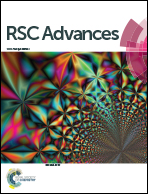Core–shell nanospherical polypyrrole/graphene oxide composites for high performance supercapacitors
Abstract
Novel core–shell polypyrrole/graphene oxide (PPy–GO) nanomaterials of uniform PPy nanospheres and GO have been synthesized by an in situ surface-initiated polymerization method. The morphology and structure of the core–shell PPy–GO composites were studied by means of techniques. Experimental results showed that PPy nanospheres with small nanospheres of only ∼70 nm were uniformly grown on the GO sheets to form continuous 3D core–shell PPy–GO nanocomposites. The smaller size of PPy can not only be more beneficial to increasing the electrochemical performance, but can also reduce the ion diffusion path and make it a higher material for utilization. Moreover, the well-designed core–shell nanostructure and synergistic effects of PPy–GO composites can clearly lead to high rates of electrode reaction and good electrode/electrolyte contact areas. Meanwhile, its electrochemical performance was evaluated by cyclic voltammetry (CV), galvanostatic charge/discharge (GCD) and electrochemical impedance spectroscopy (EIS) tests. The specific capacitance of the core–shell PPy–GO nanocomposites can reach up to 370 F g−1 at a current density of 0.5 A g−1 with a large mass loading of 8.0 mg cm−2. It is noteworthy that the cycling stability of the PPy–GO electrode was improved significantly by the core–shell nanostructures, and showed excellent capacitance retention (91.2%) even after 4000 cycles, suggesting its attractive application in supercapacitors with improved performance.


 Please wait while we load your content...
Please wait while we load your content...